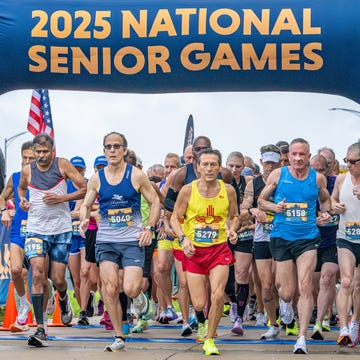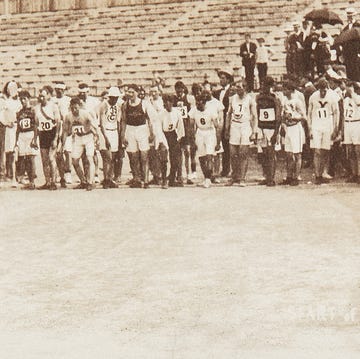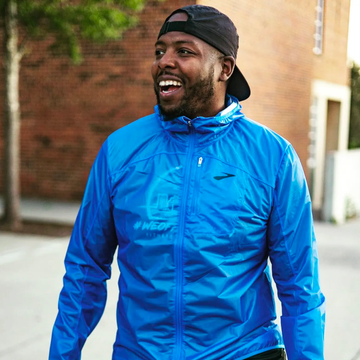In the moments before the men’s Olympic 10,000-meter final last year in Tokyo, Grant Fisher stood alongside Uganda’s Joshua Cheptegei, the reigning world champion who held the world record at 26:11.00.
Fisher, 24, was competing at his first Olympics and was the 12th fastest of 25 competitors. He looked at Cheptegei with respect and something more: reverence.
“I was like, man, this guy is exactly a minute faster than me in the 10K,” Fisher said in an interview with Runner’s World. “It is intimidating.”
Fisher had been a high school phenom and an NCAA champion. But this was in a different stratosphere—one of the strongest 10,000-meter fields ever assembled, with eight men who had run under 27 minutes. Midway through the race, he found himself running directly behind Cheptegei and, as the laps ticked by, Fisher’s mindset began to shift.
“I was thinking, he’s just another guy. He’s not superhuman.”
With one lap to run, Fisher was still there, right on the heels of the world’s best, fighting for an Olympic medal. In the end he finished fifth, only three seconds behind gold medalist Selemon Barega of Ethiopia and Cheptegei, who won silver.
Join Runner's World+ for unlimited access to the best training tips for runners
When he thinks back on that race, Fisher knows it was a key moment, perhaps the key moment, in his career.
“The company I was with were people I felt were on an absolutely different level,” he said. “But throughout that race I realized: They’re just like me, they’re guys who love to run. These guys aren’t mythical beings who can’t be beaten.
“Maybe the possibilities are different than I thought.”
“A Killer When the Time Comes”
In July, 2014, coach Chris Miltenberg made a 2,000-mile journey from Palo Alto, California, to Grand Blanc, Michigan, to convince Fisher to attend Stanford University.
It was their first time meeting, and Miltenberg saw in the 17-year-old something that made him stand out from the countless college athletes he’d coached.
“Very few had that certainty of what he wanted to accomplish, but he also had this humility,” Miltenberg said. “A lot of guys, when you recruit them, are concerned about what they can do next year. Grant knew he wanted to be world class, and was ready to approach everything with a 10- or 12-year mindset.”
There are some great athletes—most notably Norway’s Jakob Ingebrigtsen—who specialize early in running. Fisher was not one of them. For most of his life, soccer was his obsession, and only in his senior year of high school did he choose running.
“I feel that being multisport was beneficial,” he said. “You look at Jakob and he’s dominating, but if I were put in that system at 13 or 14, I’d have said, ‘Screw you guys; I’m going to play soccer.’”
On his recruiting visit to Stanford, Fisher was hosted by a group of athletes that included Sean McGorty, who would spend years rooming with Fisher on trips to college races, then later become his professional teammate at the Nike Bowerman Track Club. McGorty noticed early on that beneath Fisher’s nice-guy persona was a fierce competitor.
“He’s a super-fun guy, really chill, but also really focused, dedicated and driven,” McGorty said. “I know Grant well enough to know that if he’s not winning, it’s killing him.”
Miltenberg also recognizes those two sides to Fisher.
“Everybody remarks about how he’s such a nice guy, so sincere, and that’s 100 percent true,” he said. “But it doesn’t show the full scope of his drive, his intensity, and the competitive fire he has to go to places most people are scared to go. Grant is a killer when the time comes, and he has that in everything he does.”
Over the years, Fisher has learned to compartmentalize that instinct, which he has had since he was young. His parents often had to tell him to tone it down.
“I try to flip a switch when it’s time and be a bit more ruthless, which is what you need in our sport,” he said. “There are no friends when you’re racing.”
Fisher won the NCAA 5,000-meter title as a sophomore, but the following year, in 2018, his progress stalled, chiefly due to his academic workload. Fisher was burning the candle at both ends as he majored in electrical engineering.
Miltenberg said they had honest conversations about striking a better balance during his final 18 months at Stanford, with Fisher taking more classes over the summer to free up time during the semester.
“He wasn’t going to compromise academically, but he was willing to make adjustments to make sure there was nothing lost athletically,” Miltenberg said. “Not a lot of guys had that at Stanford, but Grant never lost sight of how great he wanted to be.”
Some coaches might be tempted to extract the maximum from a talent like Fisher’s during his college days, but Miltenberg refused to think short-term, always keeping his mileage conservative and his racing schedule light.
“We left points on the table and I’d do it every time,” he said. “He could have run faster in college if we pushed him harder, he could have won more NCAA titles, but I see what he’s doing now, and I know we did it right.”
Intense Workouts
Long before Fisher moved to Portland in October 2019, to join the Bowerman Track Club (BTC), he knew exactly what he’d be facing in the professional ranks.
His agent, Tom Ratcliffe, had several athletes in the group, coached by Jerry Schumacher, and his good friend McGorty had gone there a year earlier, shortly after winning the NCAA 5000-meter title.
“I told him there was a shift in the amount of work,” McGorty said. “I’d give him stories of the workouts, and that’s part of the reason he wanted to join. He wanted to work that hard, really test and see what he’s capable of.”
At Stanford, Fisher was doing 70 miles a week, which climbed to 80 with BTC, but the big difference was the volume of running within workouts.
“I went from doing 5 by mile to 10 by mile, from doing 10 by 200 to 20 by 200,” Fisher said. “The high-quality training volume doubled, and the intensity and paces increased quite a bit, too. It was certainly a shock.”
He handled it well in his first few months, but then his body started to break down.
“Jerry is kind of an old-school coach,” Fisher said. “He’s not going to hold your hand along the way. There’s a level he knows you need to train at to compete with the world’s best, and he’ll see if you can do it early on.”
Fisher was still running on heavy legs in the summer of 2020, when he lowered his 5,000-meter best to 13:11.68. But it was another year before he’d reap the real benefits of his work.
It took until midway through his second year with the group before he completed his first full altitude workout with the strongest runners, such as Canada’s Mo Ahmed. Before that either he couldn’t keep up or Schumacher would pull him from the session before the others.
“You have to fall into the ground a few times, especially in this group, to keep up,” Fisher said. “It definitely takes time.”
He started 2021 with big personal bests over 5,000 meters (13:02.53) and 10,000 meters (27:11.29), times that convinced him he could make the U.S. Olympic team for Tokyo.
But shortly before the U.S. Olympic Track and Field Trials in Eugene, Oregon, last June, fellow BTC athlete Shelby Houlihan was handed a four-year ban after testing positive for nandrolone, which she claimed was ingested from a burrito.
The Court of Arbitration for Sport said that explanation presupposed “a cascade of factual and scientific improbabilities, which means that its composite probability is (very) close to zero.”
During that distracting time, Fisher kept his mind fixed on his own targets.
“It was hard to focus, but I tried my best to compartmentalize it all,” he said. “I had to block everything out and not think about it, ignore it and focus on myself, selfishly.”
Fisher went on to make the Olympic team over 5,000 meters and 10,000 meters, finishing second in both races at the Trials. How does he reflect now on Houlihan’s case?
“It kind of cast a dark shadow over the team, which was a strange, strange feeling,” he said. “It’s a very unfortunate situation. If you think there’s guilt, then it casts a dark shadow on the team by association, and if you think there’s innocence, then it casts a dark shadow on the anti-doping process, which is also a bad result for the sport. It’s a lose-lose situation for everyone right now.”
Fisher is adamant that when people watch him run, they can believe what they see.
“I’d never do anything wrong or even pushing the limits of wrong, into that gray area that people talk about,” he said. “That’s something I’d never want to do and I don’t think I could look at myself the same way if I was doing something like that.”
Conscious of how cut-off elite athletes can be, Fisher made an effort in the wake of Houlihan’s case to share more of his life online, becoming more active on social media and starting a podcast with his former Stanford teammate Connor Lane.
“Certain people have distrust for elite runners, but I’ve been trying to make an effort to be a bit more transparent, to pull back the curtain and show people what we’re doing and hopefully gain some trust back,” Fisher said. “It is important to me to inspire people. I had several people inspire me when I was young and knowing your heroes are doing things the right way was really important.
“I’d hope that people don’t have that doubt when they see things I do. I just want to be the best I can be, and do things the right way.”
A Promising Trajectory
Toward the end of last summer, with the Olympics in his rearview mirror and a few weeks to unwind before fall training began, Fisher went on a short solo adventure around Europe.
He took a train to Zermatt in the Swiss Alps and spent a day hiking up the Matterhorn. After that he went to Paris, exploring the city that will host the 2024 Olympics.
In addition to his fifth place in the 10,000 meters in Tokyo, he was ninth in the 5,000 meters. He’ll be 27 at the Paris Games—and his current trajectory suggests he’ll be a major contender.
Last November, Schumacher came to him with an idea.
He believed Fisher could break Galen Rupp’s American indoor 5,000-meter record of 13:01.26. So they charted a path to the David Hemery Valentine Invitational on February 12, staged on the lightning-quick track at Boston University.
His training hit a new level in the weeks before the race, with Fisher logging 90–100 miles a week in Flagstaff and going through a series of 10-day training cycles that included one long, progressive run and three tough workouts: one speed session on the track; one strength session such as 10 x mile or 5 x 2 mile; and one race-pace track session.
One of his final workouts, which he completed in Phoenix, involved three miles of reps at his goal 5K race pace. He covered the last rep in 4:02. What made it more impressive is that Fisher is not the type to show off in training, always following his coach’s orders to a tee.
“He might be the best on the team at actually running the split Jerry gives,” McGorty said. “We did a workout before that 5K, and Grant’s rep [to lead] was an 800. Jerry said two-flat, and his splits were 60.0 and 60.3. He operates with control and composure; they embody who he is as an athlete.”
In Boston earlier this month, Fisher showed that in the opening half of his American record attempt, sitting behind the pacers, patiently biding his time. Before the race, Schumacher told him he would have to step up and really push the pace with a mile to go.
Fisher split an astonishing 3:57.56 for the last 1600 meters, bringing him to the finish in 12:53.73 and smashing Rupp’s record. Did he expect to run that fast?
“Absolutely not,” he said. “I thought maybe a touch under 13 flat, but sometimes you just get that magical day.”
It was a race that showed a new side to Fisher, an athlete unafraid to take command.
“The way he did it more than the time was what stood out to me,” McGorty said. “I’ve seen him race from high school to college and as a pro, and he’s known as someone who can close very well, but I don’t know if I’ve ever seen him take over a race the way he did.”
Miltenberg was watching online, from his home near the University of North Carolina, where he now coaches. The moment Fisher hit the front, he felt something big was about to happen.
“When he put the pedal down, I knew he knew he could follow through, because Grant is not reckless,” he said. “He’s not going to go for broke and tie up; he’s too calculated and too smart for that.”
Six months earlier, Miltenberg and his wife awoke at dawn to watch Fisher’s Olympic final on TV, and shortly after his fifth-place finish in the 10,000 meters he got a call from Fisher’s father, Dan. Both were emotional, recalling that first conversation in the summer of 2014 and how adamant they’d been that the long-term focus would lead to a result like that.
“I think over the next several years, he can become the next great American on the world stage,” Miltenberg said. “I think he’s just getting started.”
Fisher’s next opportunity to prove that is right ahead.
On Saturday evening, March 5, he will race The Ten in San Juan Capistrano, California, where he looks capable of going under 27 minutes for 10,000 meters, though he’s playing down his chances at Rupp’s American record of 26:44.36.
“That’s one of the hardest U.S. records there is in the distances,” he said. “It’d be a massive PR, almost 30 seconds, so I wouldn’t say it’s the target. The target is to be better than last year.”
Looking further down the line, Fisher hopes to make the U.S. team at both 5,000 meters and 10,000 meters for this year’s world championships, which will be held in the U.S. for the first time in July in Eugene.
He knows Cheptegei, Barega and all the world’s best will be there. While he doesn’t want to tempt fate, given he still has to make the team, Fisher knows that if he stands alongside them again, he’ll carry a newfound confidence.
“I’ll go into this one with a much different attitude,” he said. “Not thinking of myself as one of those guys who’ll just hang on as long as they can, but as a guy who can race at the front.”

Cathal Dennehy is a freelance writer based in Dublin, Ireland, who covers the sport for multiple outlets from Irish newspapers to international track websites. As an athlete, he was Irish junior cross-country champion and twice raced the European Cross Country, but since injury forced his retirement his best athletic feat has been the Irish beer mile record. He’s happiest when he’s running or writing stories about world-class athletes.
















